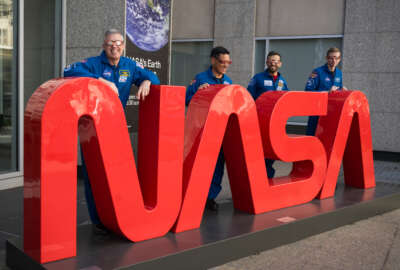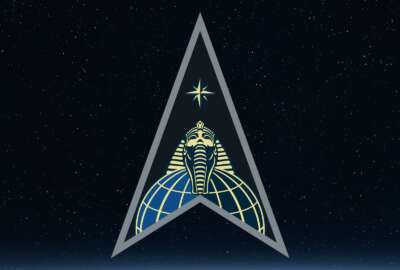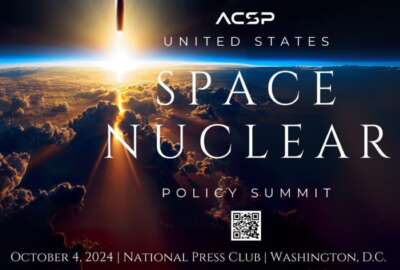A challenge to recreate how the International Space Station was built
A new challenge looks to digitally recreate the planning of each module of the International Space Station.
A new challenge looks to digitally recreate the planning of each module of the International Space Station. It’s being put on by the organization Students for the Exploration and Development of Space or SEDS. “The Ambitious Machine Challenge” will be a year long contest where participants will compete in an array of categories while simultaneously collaborating to document the build of one of humanity’s greatest engineering feats. To learn more about it and the SEDS organization overall, I spoke to Theodore Courtois, he’s chair of its Board of Directors.
Interview transcript:
Theodore Courtois SEDS USA is the National Organization for Students for the Exploration and Development of Space. This is A5A1C3 nonprofit. It was founded as a chapter organization back in 1980 at M.I.T. and then founded as a national organization shortly thereafter in 1982. So it’s the largest student-run space organization in the world. We have over 90 chapters all across the nation, and we have sister organizations spanning the entire globe. So there’s a SEDS Mexico SE Canada, and then we have a sense earth that encompasses all of them. And so for the past 40 years, Said has been equipping the future space industry leaders with the technical networking and leadership skills that are necessary for them to meet the challenges of the cosmos. We have many different events that we host, different competitions to get these 90-plus chapters involved with really getting the hands on experience and the skills that they need for their future in the space industry.
Eric White I’m not going to ask you to namedrop unless you want to, but it has the types of folks who end up in the space program. What are the types of industries and arenas of study? Do they typically go into afterwards or do they still remain a part? Is this a lifetime thing or are you in there for life, blood in blood to get out?
Theodore Courtois That’s a fantastic question. So we do typically see that people who are involved with Seds either on the chapter or national level, they continue coming back even after they’ve bridged that gap and down to their careers in the space industry. If you look back at the Seds Nationals previous board of directors, previous executive directors, you’ll kind of see that it’s almost a who’s who of the space industry today. So we have lots of fantastic previous members who end up moving on to be the founders and the CEOs of the next generation of the space workforce. And we find it like I mentioned, they keep coming back time and time again. We see them at every space vision, speaking to our students, inspiring the students, helping them find their place in the space industry. And so that’s one of the really great things about Seds is you’ll hear people who talk about Seds who are really passionate about it, say that I would not be where I am in the aerospace industry if I hadn’t gone to my first space vision, which is our national conference that we host every year. And then they tell their story and they inspire the next generation that’s going to come after them, who do the same thing and inspire the next group of students and the next group of students. And by doing this, we’re able to build this really incredible close-knit community that just keeps giving back to itself. And so we’re able to continue expanding our influence in the aerospace sector and continue being a positive driver for change in the industry.
Eric White I want to get into this most recent project, which was the reason I reached out to you all. But if we can just kind of get an overview first of the types of projects that Seds tackles and gives experience to those who are looking to, as you mentioned, network, but also kind of get their feet wet and see if this is something that they want to do for a living.
Theodore Courtois Yeah, absolutely. So the great thing about Seds being a chapter-based organization that also has a national level of support is that we’re able to do a really broad range of things, both individually at the chapter level and then together at a national level. So our chapters do really amazing things, ranging from rocketry competitions. We have chapters that compete in the Spaceport America Cup every year. We have chapters that compete in the spun debates, which is a space debate held by the National Space Society. They do all kinds of amazing things at the chapter level and then at the national level, we’re able to bring them together for some larger competitions, which include things like our SSPI competition that we host every year. This past year, there was a competition related to satellites. The previous year, there was a competition related to building sort of a mars gateway, kind of similar to the lunar gateway that’s being developed. And that’s a really cool research competition where chapters don’t necessarily have to fundraise to be able to participate and they’re able to do research and really bring in a bunch of interdisciplinary students with different majors and focuses to contribute to the same project.
Eric White We’re speaking with Theodore Courtois. He is a board member for the Saids program. And so speaking of the ambitious Machine challenge, what is it and what does it aim to do and how will members of Seds be able to participate?
Theodore Courtois I’m so. I did talk about this challenge with you. So the ambitious machine’s challenge is being put on by one of our sponsors and partners Integrate. John Conafay, the CEO of Integrate he is a previous SEDSboard member and SEDS executive director. He was also part of Seds ASU at Arizona State University, where I’m currently going to school. So it’s really great to be able to connect with him and have him support our students through this. So Integrate is a program management software for developing the world’s most ambitious machines. And the way that we are running this competition is students from all across Seds USA are going to come together and build a replica of the International Space Station’s program management from start to finish. And this is a really incredible and ambitious challenge because it’s allowing these students to do something sort of historically unheard of. So this is going to be a really amazing project that allows for the historical recreation of the program, management of such a vast collaboration between so many countries and so many different companies, departments, groups, all working together to build this amazing thing that we have in space right now. And to understand the collaboration and the cooperation that took to help replicate it in the future, and then simultaneously understanding how software such as Integrate can help us continue to do these amazing things in space. And so we have many different chapters. I think we have 30 chapters collaborating for this competition. And while it is a competition, it’s also a really large-scale collaboration. So each of these chapters is going to take an individual module of the International Space Station and replicate the program management for that specific module. So we’ll have students at ASU working on one module, students at MIT working on another module, students at A&M working on another module, and they’ll all work together to incorporate those modules into the larger program management for ISIS as a whole. And with integrate, you have the ability to create builds, add tasks, drivers and milestones to those builds track requirements down through the different builds, all different ways to connect and track and move the Gantt chart along all together. And so by being able to link all of these different builds and projects, we’re really going to be able to see how all of those modules interact and the students are going to be able to collaborate and communicate with each other across the nation.
Eric White That sounds fascinating. And one weird curiosity question I had to ask. I was surprised that NASA’s and commercial space companies, the training is to the nth degree. I’m surprised that with virtual reality popping up and becoming more and more a part of training in other areas, not even in space, that one, a 3D environment of the ISS, had not been built yet since, like I said, the training is so extensive. That would be something that I thought that would be in place already. No.
Theodore Courtois Yeah. So it’s interesting. You know, there are a million fantastic opportunities for NASA’s training. You have things like in class now, community college, aerospace scholars. You have things like the NASA’s space program, where students learn to put together a mission kind of from start all the way to PDR. But throughout all of these different programs, programmatic. So this side of the space industry where you’re talking about budgets, schedules, timelines, really building out all of these connections, that’s not touched on as much. So the really cool opportunity with this ambitious MSI Machines challenge and with integrate is that students are going to get exposure to that programmatic side, which very frequently they don’t actually get exposure to until they’ve graduated and they’re already in industry. So it’s a really great opportunity for our students to sort of build out that skill set and set themselves apart from other applicants as they’re moving into their careers.
Eric White Can’t all be astronauts. It takes some programmatic aspects to make these things happen, Right?
Theodore Courtois Exactly. Exactly.
Eric White Well, let’s use that as a vessel to start the focus back on you. Where are your areas of interest and how did you become involved in Seds and what are you looking to take place? I don’t want you to lay out your five-year plan. I’m not your dad, for God’s sakes. But what do you have going on in your world?
Theodore Courtois So that’s a really great question. I actually changed my major two years ago when I first found out about Seds. I was transitioning from being an education major to focusing more on engineering, and I was looking for space opportunities that my college at the time I was at a community college, Austin Community College in Austin, Texas, and I found Seds and my mind was just blown that there was this national organization committed to connecting students with the space industry. And so I immediately set out to found my own chapter at Assisi because we didn’t have one. And then over two years, we kind of took that chapter from absolutely nothing at the start to having 50-plus members developed in L one rocketry certification program. We’re really able to get students there L1 certification with little to no cost. So trying to make sure it’s not cost-prohibitive. And then within the second year, we actually competed ourselves at Spaceport America. And launched a rocket to 10,000ft, which was such an incredible feat for a brand new chapter. And then I transitioned to Arizona State University, and now I’m working with both sides, ASU and it said ASU rocketry division there. So last year was actually my my first space mission, the one in DC, and being there, being among like-minded individuals, people passionate about space. I was so excited and I knew that I wanted to give back to the community. So I ran for a board position. Last year, I was fortunately elected to the member at large position and I did a lot of work with trying to bring more people into the room and increase the diversity at Ted’s USA. Just to make all of the people who wanted to be in the space industry, who wanted access to that room, were able to get there. And I continue to do that now. I was fortunate enough at this past Space Vision in Denver to be elected to the chair of the board of directors position. And I just want to continue that work, continuing opening up access and increasing the ability for everyone who wants to be involved, multi-disciplinary students, people from all different backgrounds to have access to the space industry, because it’s through those diverse perspectives that we’re going to be able to solve the most difficult challenges that we face.
Eric White Well, let me give you an opportunity to continue that work. What are some of the ways that folks who are looking to get involved can do so, start their own chapter or join one that may be already right down the road from them?
Theodore Courtois That said, Sorg, we do have a chapter list of all of our chapters currently in the United States. If you are out there, if you’re interested, if you want to be a part of it, please visit that website and we’d be happy to have you look up the chapters, see if there’s one at your local university and there is contact information there for you to reach out to join. If there is not a chapter at your local university, please get in contact with us. There’s contact information on our website and we would love to help. You found a chapter in your university. We’re always looking to help new students get involved in the space industry and we will walk you through that entire process. It might seem daunting at first, but we are there to help you every step of the way and get you involved.
Copyright © 2024 Federal News Network. All rights reserved. This website is not intended for users located within the European Economic Area.
Eric White is news anchor and Federal Drive producer at Federal News Network.
Follow @FEDERALNEWSCAST






